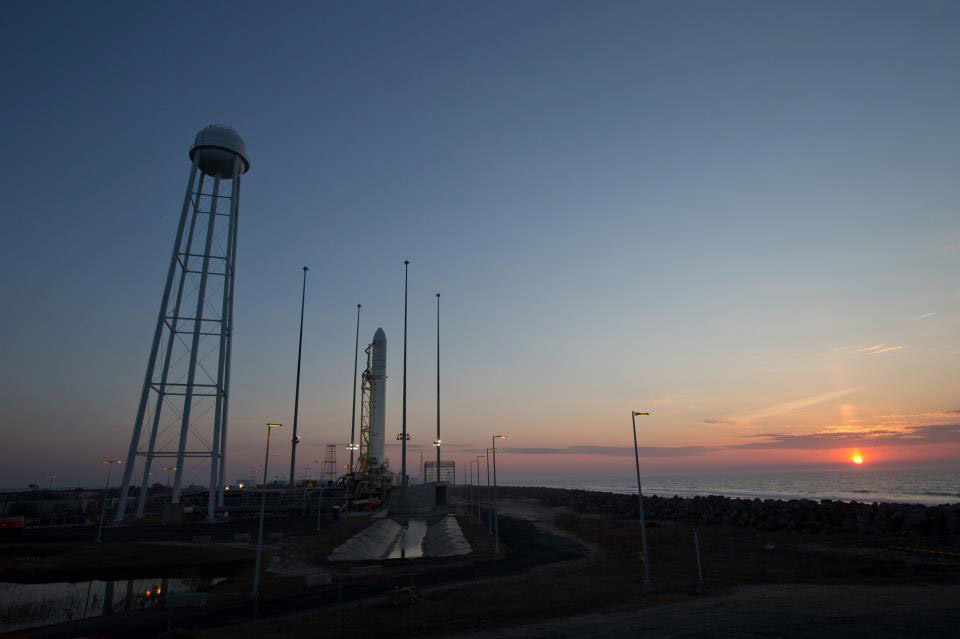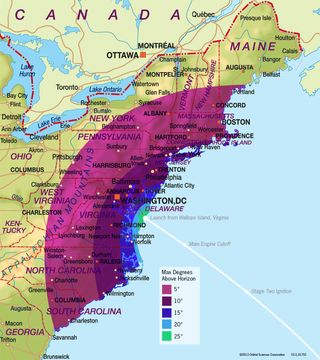
It's been a long road for the private cargo-launching Antares rocket, which is set to blast off on its highly anticipated first test flight Wednesday.
Aerospace firm Orbital Sciences Corp. began developing Antares in earnest in 2008, when the company scored a NASA contract to fly robotic cargo missions to the International Space Station. Five years later, after a name change and a series of delays, the rocket is now ready to blast off Wednesday (April 17) afternoon from a newly refurbished launchpad at Virginia's Mid-Atlantic Regional Spaceport (MARS).
"We've worked really hard over the last several years to go develop this new launch vehicle and a new launch site," said Mark Pieczynski, vice president of business development for Orbital's launch systems group. "We've got a great deal of confidence that our launch vehicle and the launch site are both ready to demonstrate their capabilities." [Antares Rocket's First Test Flight (Photos)]
Antares is slated to blast off at 5 p.m. EDT (2100 GMT) Wednesday. You can watch the launch webcast live here at SPACE.com, courtesy of NASA.
Private cargo delivery

The NASA contract pays Orbital $1.9 billion to make eight unmanned supply flights to the space station using Antares and a spacecraft called Cygnus. The agency also signed a $1.6 billion deal with California-based SpaceX for 12 missions with its Dragon capsule and Falcon 9 rocket.
Dragon has already completed two of those contracted supply runs, delivering cargo on flights in October 2012 and this past March. Dragon also successfully rendezvoused with the orbiting lab in May 2012 on a demonstration mission.
Get the Space.com Newsletter
Breaking space news, the latest updates on rocket launches, skywatching events and more!
It has taken Antares — which was called the Taurus 2 until Virginia-based Orbital changed its name in 2011 — and Cygnus a bit longer to get off the ground, partly because their launch pad wasn't ready yet.
MARS is overseen by the Virginia Commercial Spaceflight Authority and located at the southern end of NASA's Wallops Flight Facility, which has hosted the liftoffs of many sounding rockets and other small launch vehicles over the years.
MARS' Launch Pad 0A was constructed in 1995 for the now-defunct Conestoga rocket, and then rebuilt to accommodate Antares and Cygnus. The upgrade did not always go as smoothly as Orbital officials had hoped, causing some schedule slips.
But everything is ready to go now, and Wednesday's launch will break in a new jumping-off point for flights to the International Space Station. (SpaceX's cargo missions lift off from Cape Canaveral, Fla., a storied launching ground for many manned and unmanned spaceflights over the years.)
"There have been a lot of launches from Wallops; I think the number of launches exceeds 14,000," Pieczynski told SPACE.com "But this will truly be the first opportunity to launch anything from Wallops to go to space station."
The test flight

Antares and Cygnus won't fly together Wednesday. Antares' maiden launch — which Orbital is calling A-ONE — will instead carry a Cygnus "mass simulator" and a handful of tiny satellites to an expected maximum altitude of between 155 miles and 185 miles (249 and 298 kilometers).
If all goes well with the 10-minute test flight, Antares and Cygnus could launch on a demonstration mission to the space station by late June, Orbital officials say.
The company is excited to see the 131-foot-tall (40 meters) Antares get off the ground and help pave the way for bona fide cargo runs.
"SpaceX looks like they've done a pretty good job," Orbital spokesman Barron Beneski told SPACE.com. "Now it's our turn at bat."
Visit SPACE.com for complete coverage of Wednesday's Antares rocket test flight.
Editor's note: If you snap a great photo of Orbital's Antares rocket launch that you'd like to share for a possible story or image gallery, send photos, comments, and your name and location to managing editor Tariq Malik at spacephotos@space.com.
Follow Mike Wall on Twitter @michaeldwall. Follow us @Spacedotcom, Facebook or Google+. Originally published on SPACE.com.
Join our Space Forums to keep talking space on the latest missions, night sky and more! And if you have a news tip, correction or comment, let us know at: community@space.com.

Michael Wall is a Senior Space Writer with Space.com and joined the team in 2010. He primarily covers exoplanets, spaceflight and military space, but has been known to dabble in the space art beat. His book about the search for alien life, "Out There," was published on Nov. 13, 2018. Before becoming a science writer, Michael worked as a herpetologist and wildlife biologist. He has a Ph.D. in evolutionary biology from the University of Sydney, Australia, a bachelor's degree from the University of Arizona, and a graduate certificate in science writing from the University of California, Santa Cruz. To find out what his latest project is, you can follow Michael on Twitter.










